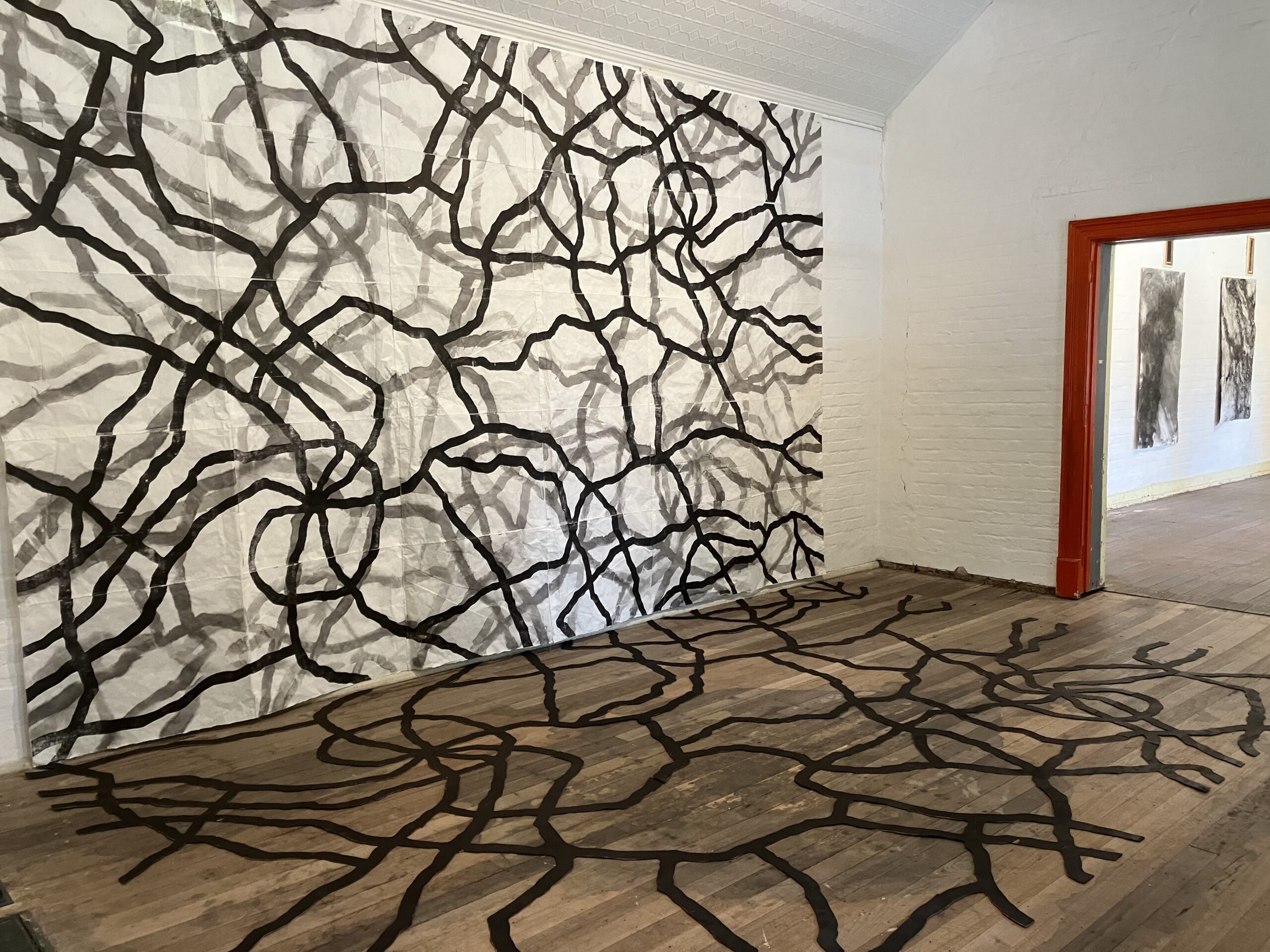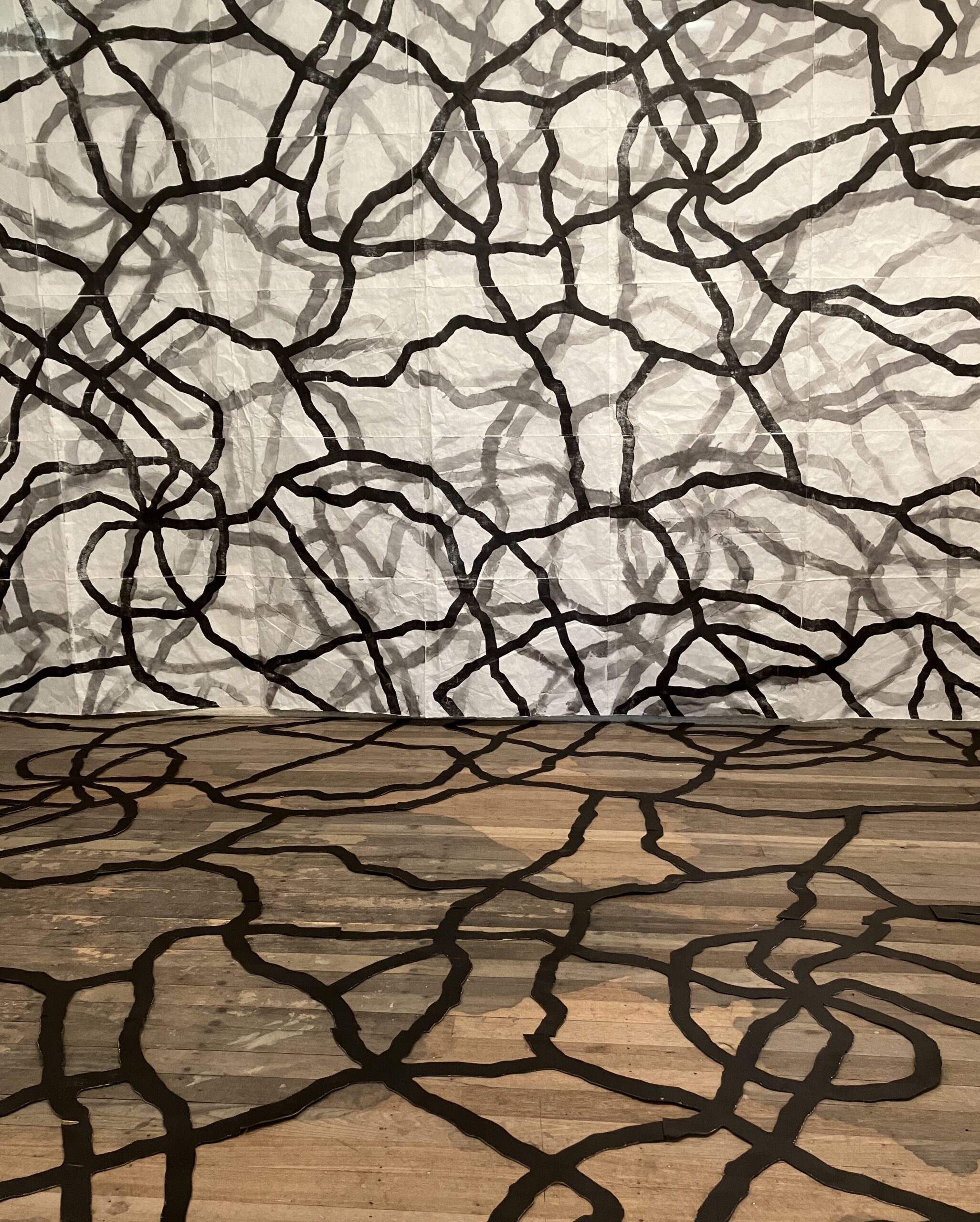
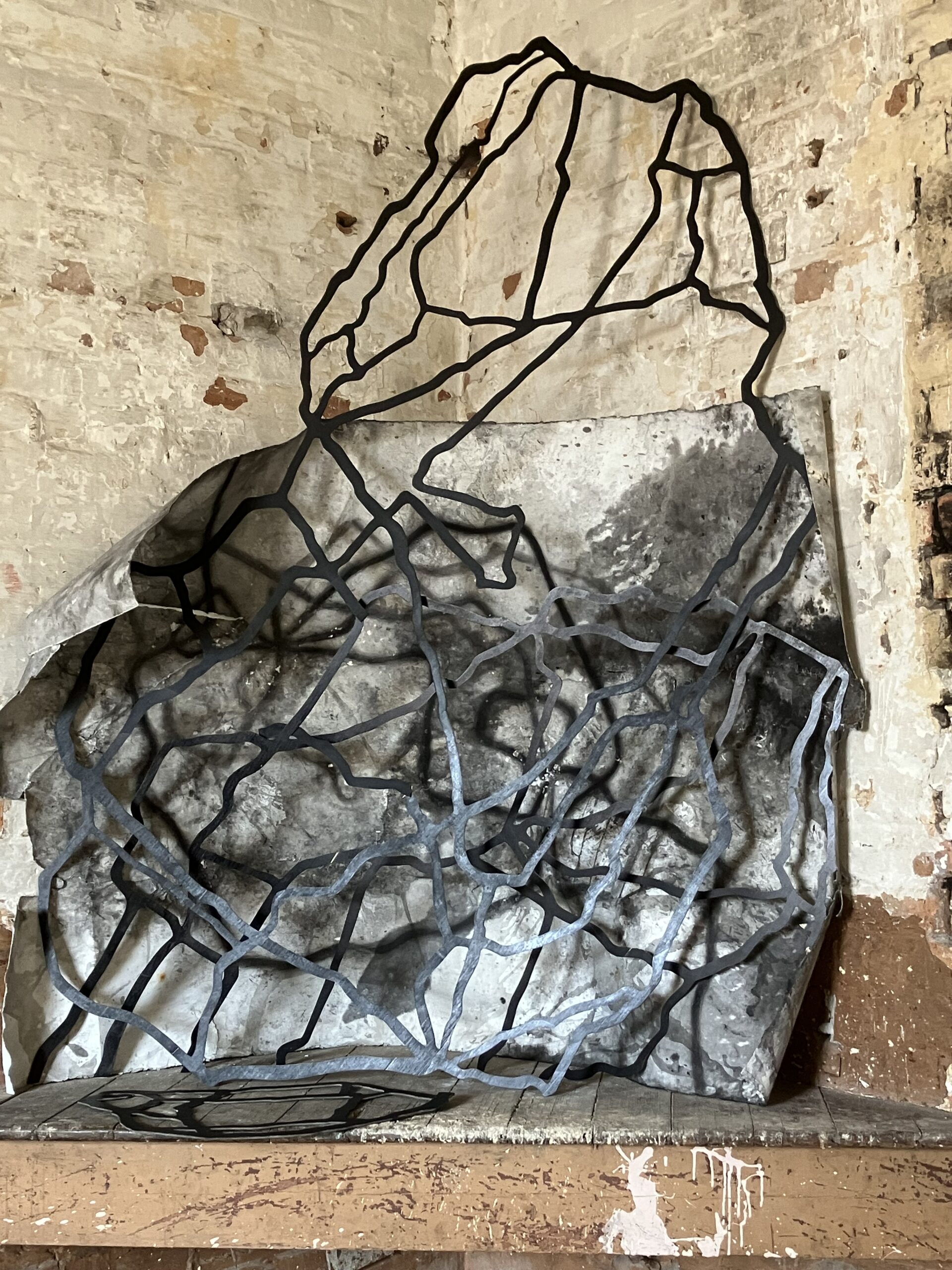
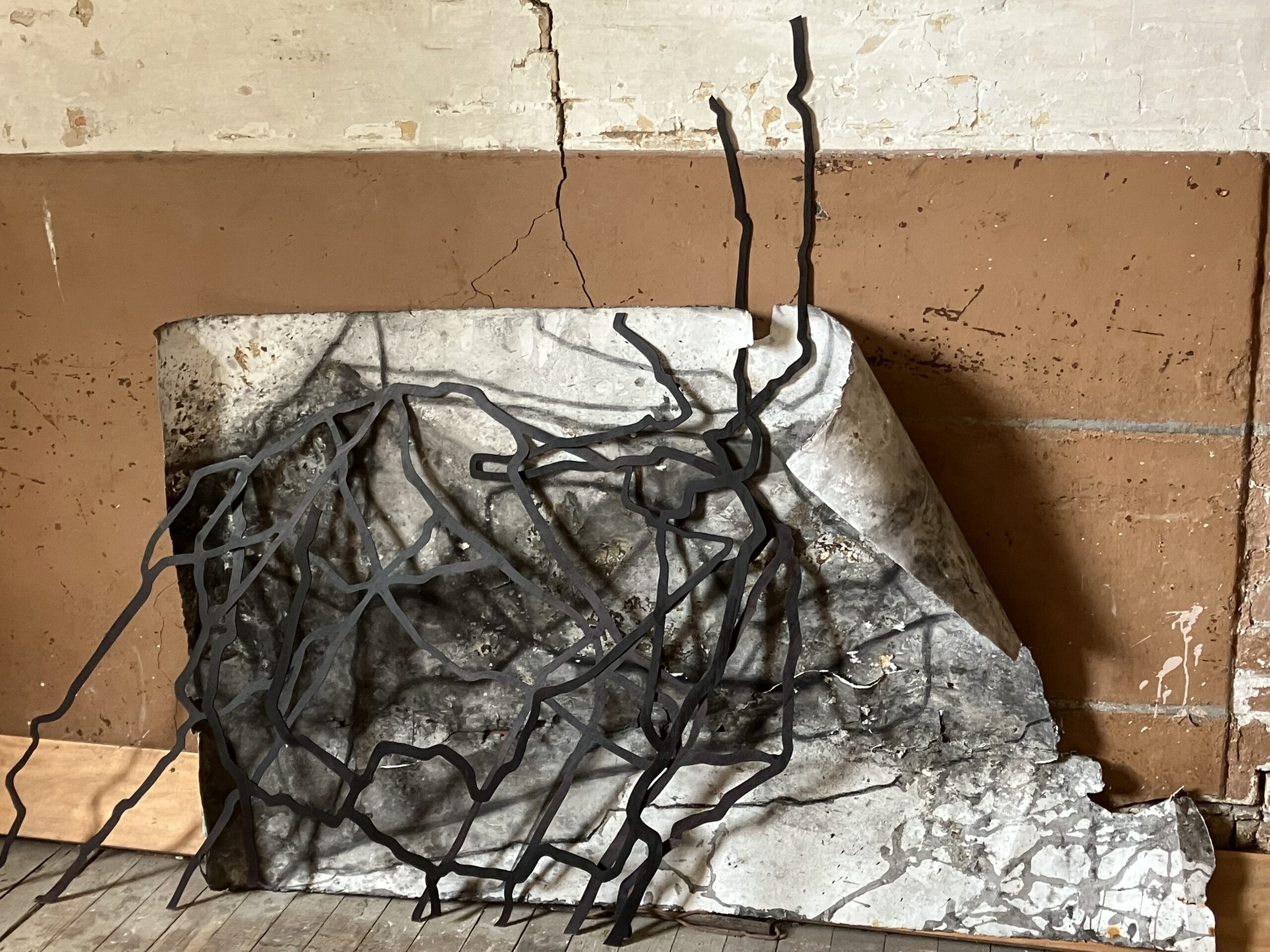
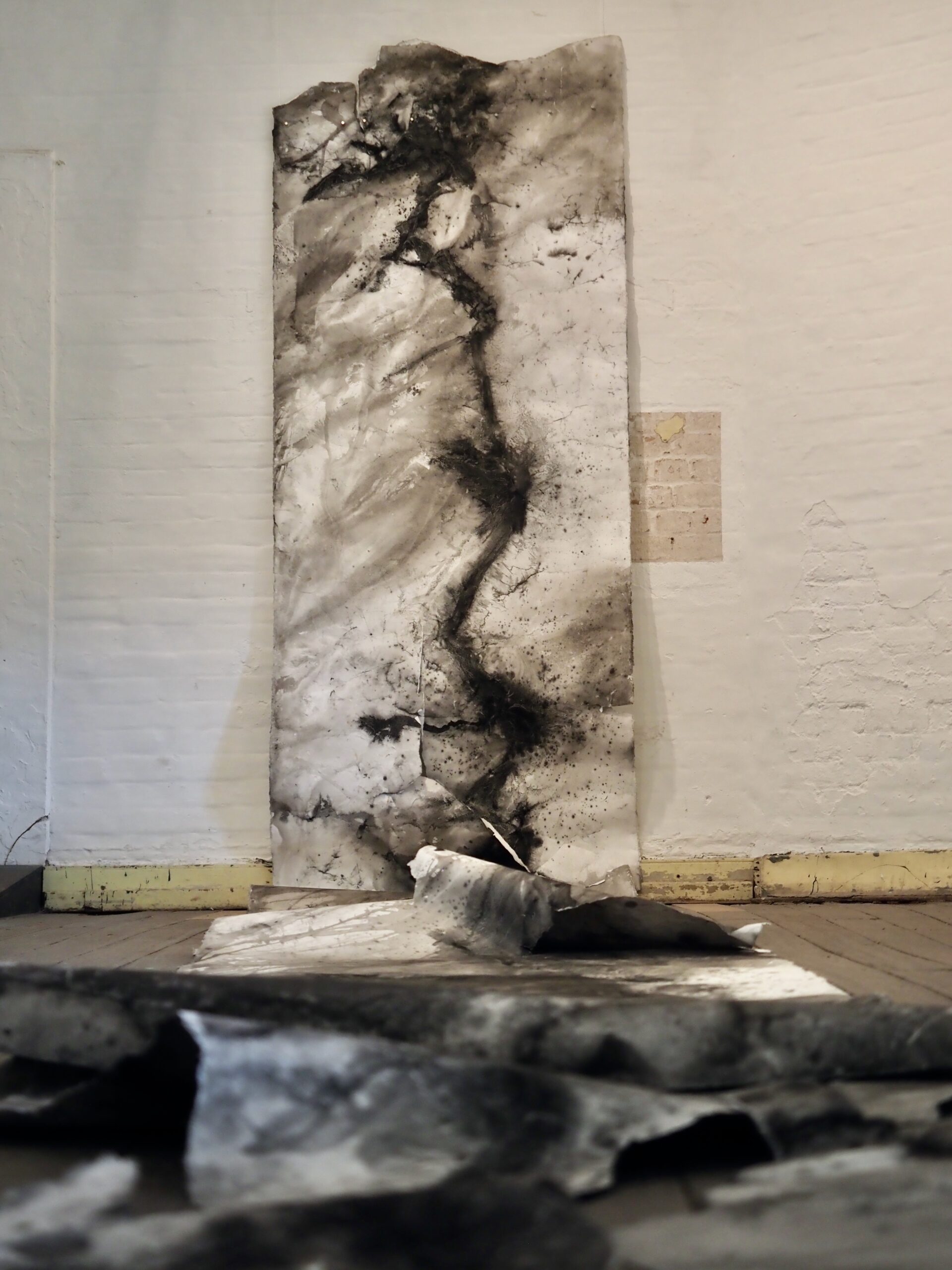
From top: Jan Hogan
Installation of Becoming Attached.
Protective measures, 2022, woodcut on kozo paper, 3 m x 4m, and plywood woodcut matrix on floor, 3m x 4m
gathering III, 2022, Rives BFK, sumi ink, charcoal, freshwater, saltwater and plywood, dimensions variable
gathering II, 2022, Rives BFK, sumi ink, charcoal, freshwater, saltwater and plywood, dimensions variable
The porous line, Hinsby Beach, 2018 – 2022, sumi ink with saltwater & freshwater on roll of Rives BFK, 9 m x 1.2 m
Q: What were some of the foundation ideas for this exhibition project?
A: This exhibition is based on Hinsby Beach on the Derwent River estuary. Through drawing and printmaking I immerse myself in the environment and learn more about its patterns and rhythms. As I both walk and swim along the tidal zone I am interested in how the space is shared by species with different needs. As a land living creature I am fascinated by the world within the river. The Derwent estuary is a fecund mixture of saltwater and freshwater that is rich in biodiversity. As we are in the midst of an environmental crisis I am interested in becoming sensitive and immersing myself in this ecology.
I am inspired by Australian and Torres Strait Islander artworks that demonstrate their responsibilities to the land through networks of kinships to both people and the more-than-human world. I am searching for a language as a settler Australian to draw the place that I live in and build connections to the more-than-human world. As a drawer and a printmaker I am interested in how materials and atmospheres influence the meaning of a work. My specialty training was in lithography so I have been especially interested in the co-development of rocks and water in creating the Derwent River estuary. I allow the atmosphere and materials of the site to be an intrinsic part of the creative act. I use rocks from the site to understand the formation of the land and by holding these whilst drawing I feel a kinship to place and an understanding of place as three-dimensional and all encompassing. By drawing these rocks I have developed marks that shift between the macroscopic and microscopic and continue to shift our viewpoint. I aim to shift away from the western landscape tradition with a horizon line that acknowledges the vertical human body to develop an understanding of the multiple viewpoints within place.
Q: How did the artwork selection take place?
A: The exhibition was an opportunity to show large scale experimental works and I gathered a large collection of drawings and woodblock matrices and tested them in the space. I am interested in process, and some of these works have been developed over 5 years. I particularly wanted to show drawings that provided insight into the different moods of the river and a sense of shifting from land to water.
I also had the opportunity to do a large-scale site-specific woodcut, Protective measures, that interacts with the space of the gallery. The print is stitched together and hangs as a shroud. The woodcut matrices sit on the floor, mirroring the print, suggestive of water reflections. The installation brings attention to the stains of the wooden floorboards and the history this room has been witness to. I think of it as a protection against the powerful histories and energies within both the site of Hinsby Beach and of the Barracks Gallery.
Q: How does the exhibition manifest – what do visitors experience?
A: The Barracks Gallery is an historic building in the Derwent Vallley. It was once part of the Willow Court Asylum. It is comprised of four rooms that have been partially restored and the works have been installed in response to the dynamics of each room.
Room 1 has been left with natural lighting. It is not fully restored and has a dishevelled appearance. In this room are 3 site specific works gathering I, gathering II, gathering III. I used wooden matrices from previous works on the Derwent River as props to hold up drawings that had been immersed in the river. The woodcuts produced shadows that intertwined with the lines within the drawings. They provide acknowledgment of the decay of matter and the entanglement of the natural and cultural worlds within a place.
In the 2nd room the large-scale woodcut Protective measures, dominates. The breeze from gaps in the walls and of passing bodies makes the shroud of paper breathe within the space. The woodcut matrices on the floor echo the patterns of water and seaweeds from the site of Hinsby Beach and become part of the space revealing the stained decaying structure of the floor.
The 3rd room has 4 large drawings, Hinsby Beach dialogues, that reveal rhythms and patterns made directly from the site. They provide different viewpoints from aerial perspectives, to surface patterns to the light shining through the surface of the water.
In the fourth room is The porous line, Hinsby Beach, a roll of Rives BFK that runs down the wall and across the floor. It is fragile and in the midst of decay. Seaweed is embedded and the inks and charcoal have soaked through the entire membrane. It holds the traces of years of repeated immersions within the river and the differences that saltwater and freshwater have on matter.
Q: What are some of the key works and what subject matter do they deal with?
A: The Porous Line was developed over 4 years directly on the site of Hinsby Beach. I am interested in the tidal zone of the Derwent River in Tasmania. The line traverses an area that I can either swim, or walk over, depending on the alignments of the moon and flow of the current. This allows multiple perspectives from the floating aerial, the embodied walking and the visual distance of landscape. I have developed this process of drawing through my engagement with the many sites I have lived in around Australia. I use the process to engage with a site and to allow the site to permeate the membrane of paper both physically and atmospherically. I think of it as an expansion of a line to understand what is contained within an informed drawing of the landscape. I aim to shift away from the western landscape tradition that separates the viewer from the environment.
gathering I, gathering II, gathering III, 2022, Rives BFK, sumi ink, charcoal, freshwater, saltwater and plywood, dimensions variable; These works were applying the methods of accumulation that occur on Hinsby Beach after storms. Seaweed, sticks and detritus accumulate around rocks and as I was sorting works in my studio I piled drawings and print matrices against the wall and was struck by the similarity to the environment. They echo my sentiment that the Derwent estuary is a creative zone in itself.
Protective measures, 2022, woodcut on kozo paper, 3 m x 4m, and plywood woodcut matrix on floor, 3m x 4m This print is inspired by Aboriginal artworks from Eastern Arnhem Land where a crosshatching, called a rarrk, is applied over areas of the bark paintings as a protective measure against the energy of ancestral spirits in particular sites. I work with the idea of rhizomes that protect estuaries as they gather around rocks and provide a rich ecology that sustains the river.
Q: What is it about the printmaking experience that you most appreciate?
A: I love the way in which the print process transforms marks and ideas. Through the translation of an idea onto other surfaces, matter begins to have a say. I find I enter into a dialogue with all the elements and I am constantly surprised by what they reveal to me. Pulling a print from a matrix remains a magical moment, often heartbreaking but always presenting something new.
—
Jan Hogan, Becoming Attached, The Barracks Gallery, 11 The Avenue, New Norfolk. Exhibition Opening Times: 11am – 4pm; 10, 11, 17, and 18 December 2022, 14, 15, 21 and 22 January 2023
Becoming Attached is an exhibition of works created in dialogue with the Derwent River. The small bay of Hinsby Beach is a source of sustenance for the local ecology, inclusive of the human and more-than-human. Drawing assists in developing familiarity and attachment to the rocks, rhythms, and habits of the Derwent estuary. Atmospheric conditions transform the drawings revealing the mysterious world above and below the tidal line.
—
Join the PCA and become a member. You’ll get the fine-art quarterly print magazine Imprint, free promotion of your exhibitions, discounts on art materials and a range of other exclusive benefits.

